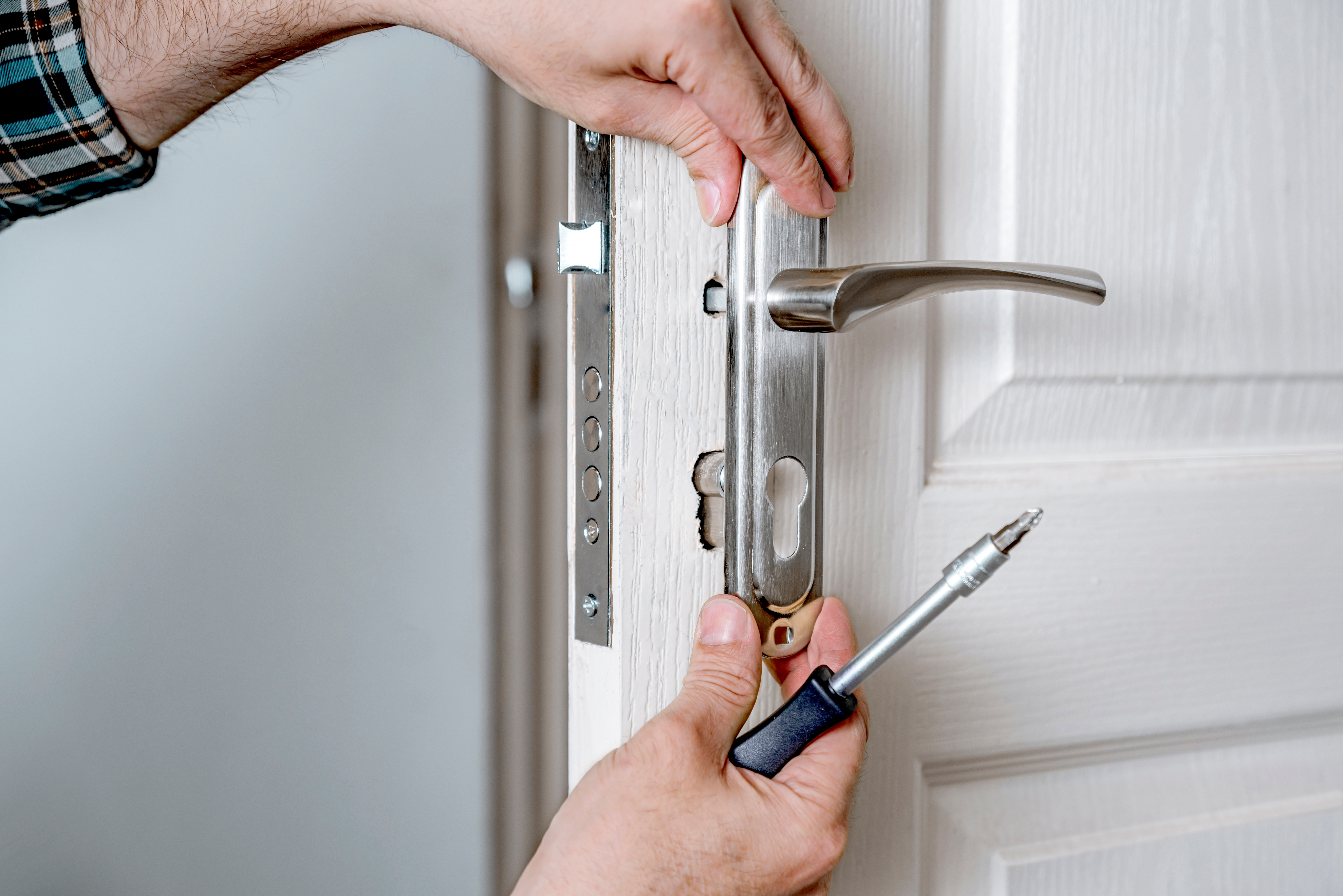If you’re planning a door replacement or new build, knowing what to expect from the interior door installation process can save time and ensure a smooth result. Even straightforward projects involve key steps that make the difference between a clean fit and making constant adjustments.
In this guide, we’ll walk through each stage of installation, outline the typical timeline and share what homeowners and contractors alike can expect from start to finish.
Get Expert Help With Your Door Installation
Step One: Pre-Installation Prep
Every great door installation starts long before the first hinge is attached. Proper preparation helps ensure a perfect fit, smooth swing and clean finish, saving time and avoiding costly rework down the line.
Measure Twice, Install Once
Accurate measurements are the foundation of a successful install. Check both the width and height of the existing opening, as well as the squareness and depth of the frame. Even a slight variation can cause sticking, uneven gaps or latch misalignment once the door is hung.
Inspect and Align the Frame
Before bringing in the new door, take a moment to evaluate the existing frame. Make sure the jambs are level and plumb, and that there’s no warping or water damage. If the frame isn’t sound, replacing it before installation will save significant frustration later.
Choose the Right Door Type
Your installation approach depends on whether you’re using a pre-hung or slab door.
- Pre-hung doors come with the frame, hinges and hardware already attached, making them ideal for new construction or when an existing frame needs replacing.
- Slab doors are just the door panel itself, designed to fit into a preexisting frame — perfect for cosmetic upgrades or simple replacements.
Plan Hardware and Finish Early
Before installation day, confirm details like hinge style, handle placement and finish. Whether you prefer a painted surface or natural stain, having materials ready ensures a seamless workflow once the door is installed.
Step Two: The Installation Process
Once the prep work is done, it’s time to bring everything together. This step is all about accuracy, from alignment to hardware placement, ensuring every door fits and functions exactly as intended.
Set the Frame
With pre-hung doors, the frame arrives ready to install. Center it carefully within the rough opening and use shims to make sure it’s perfectly plumb and level before fastening it in place. A balanced frame ensures a consistent swing and prevents gaps once the casing is added.
Hang the Door
Next comes the alignment. For pre-hung doors, the slab is already attached, so this step is mostly about confirming clearances and adjusting shims. For slab doors, hinges are mortised into the frame, and the door is hung manually, requiring exact placement for a clean reveal along all edges.
Check the Fit
Before finishing, open and close the door several times to confirm it swings freely, latches properly and sits flush within the frame. Minor tweaks to the hinges or shims may be needed to perfect the motion and seal.

Step Three: Finishing Touches
The final phase of interior door installation is all about precision and polish. Small details, from trim alignment to hardware placement, are what give the finished door its professional look and lasting performance.
Install Trim and Casing
Once the door is secure, add casing or moulding around the frame to conceal gaps and create a clean transition between the wall and door. Take care to match trim profiles and miters for a seamless finish that complements the surrounding design.
Seal and Caulk Gaps
Even a well-installed door can have small seams where air or light can pass through. Use caulk or sealant along the edges and corners to improve insulation and give the frame a crisp, uniform appearance. This step also helps protect against moisture and long-term wear.
Apply Paint or Stain
If your door isn’t pre-finished, now’s the time to customize the color or finish. Whether you’re matching interior trim or creating contrast, use high-quality paint or stain and allow proper drying time between coats for a smooth, durable result.
Add Hardware and Adjust the Closure
Install the handle, latch and any additional hardware once the finish is complete. Check that the latch aligns properly with the strike plate and that the door closes evenly without rubbing or sticking.
Enhance Performance and Comfort
For homeowners who value quiet and comfort, consider upgrading to solid-core doors or adding soundproofing seals. These options improve acoustics, reduce noise transfer and provide a more substantial feel when opening and closing the door.
Request an Interior Door Quote
Installation Timeline: What to Expect
A typical interior door installation process moves through a few clear phases. Here’s what most homeowners and contractors can expect, plus a look at how timing can vary depending on project size and materials.
- Planning & Ordering (1-2 weeks)
This stage includes measuring openings, selecting styles, confirming swing direction and ordering materials. For a single door, this step may only take a few days, while larger or custom projects can extend to about two weeks, depending on lead times and finishes.
- Installation (1-2 days)
Most single-door installations take just a few hours, including setup and alignment. Larger projects, or those involving multiple doors or custom configurations, may take a full day or two. Pre-hung doors are typically faster to install since the frame, hinges and slab come preassembled. Slab doors require more customization, such as hinge routing and on-site fitting.
- Finishing & Cleanup (1-2 days)
If doors need to be painted, stained or sealed, allow extra time for finishing and drying. Pre-finished options eliminate this step entirely, offering a cleaner, faster turnaround.
However, several factors can influence how long an interior door installation takes, including:
- The number of doors being installed
- Custom finishes or specialty hardware
- Site conditions, such as uneven floors or damaged frames
- Weather, particularly for exterior or open-air installations
Pro vs. DIY: Which Is Right for You?
Not every door installation requires professional help, but not every project should be a DIY job, either. Knowing when to handle it yourself and when to call in the pros can save you time, money and frustration.
When DIY Makes Sense
If you’re replacing a single interior slab door within an existing, square frame, a DIY approach can be completely manageable. These projects typically involve minimal tools and no structural work — just aligning hinges, installing hardware and applying a finish. With patience and attention to detail, most homeowners can achieve a clean, functional result.
When to Hire a Professional
More complex installations benefit from expert handling. It’s best to hire a professional if:
- The frame is warped, damaged or uneven, which can make proper alignment difficult
- You’re installing pre-hung doors, which require precise leveling and shimming
- The project includes multiple doors, especially in remodels or new builds
- You’re working with custom, oversized or specialty designs where precision and fit are critical
At 1st Choice Door & Millwork, we partner with builders, remodelers and homeowners across Central Florida to deliver reliable materials and expert guidance for every kind of door installation. From classic interior designs to custom architectural builds, our team helps ensure every door fits perfectly and performs beautifully.
Common Mistakes to Avoid
Even the most straightforward interior door installation can go off track if a few key details are overlooked. Avoiding these common mistakes helps ensure your door fits perfectly and performs smoothly for years to come.
- Measuring Only Once
Always double-check your measurements before cutting, trimming or ordering a door. Even a small error can lead to uneven gaps or a door that won’t close properly.
- Ignoring Flooring Height and Clearance
Failing to account for finished flooring, especially new carpet or tile, can result in a door that drags or won’t open fully. Measure from the finished floor, not the subfloor, to ensure proper clearance.
- Skipping Edge Sealing
Unsealed edges can absorb moisture over time, leading to warping or swelling. Always prime or seal all sides of the door before painting or staining, including the top and bottom edges.
- Overlooking Swing Direction
Before installation, confirm which way the door should open. Hanging a door on the wrong side can interfere with furniture placement or traffic flow, and correcting it after the fact means starting over.
- Rushing the Finish Work
Trim, paint and hardware may seem like final touches, but they make or break the finished look. Take the time to let the paint fully cure and align the casing for a clean, professional appearance.

Bring Your Project Together With 1st Choice Door & Millwork
Installing interior doors is a straightforward project when you have the right preparation and materials. At 1st Choice Door & Millwork, we make it easier with reliable products, expert guidance and fast delivery throughout Central Florida. Whether you’re updating one room or outfitting an entire home, our team can help you find doors that fit perfectly and perform beautifully.
Ready to get started? Contact us today for a quote or to schedule your interior door consultation.

